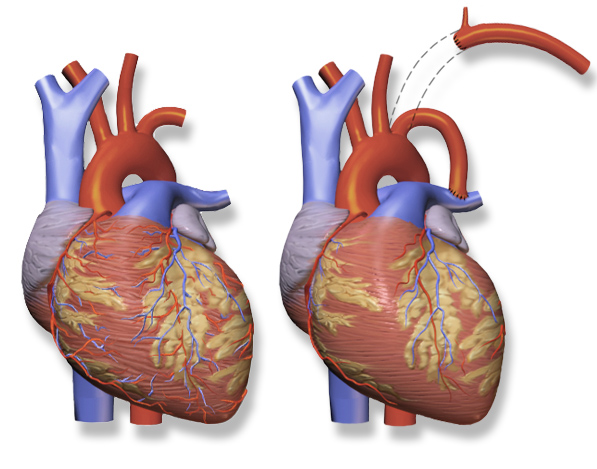Blalock-Taussig shunt: Difference between revisions
| Line 38: | Line 38: | ||
|- | |- | ||
|The relative diameter of subclvian artery prevents excessive blood flow to lungs | |The relative diameter of subclvian artery prevents excessive blood flow to lungs | ||
|Thrombosis of shunt due less diameter | |Thrombosis of shunt due to less diameter | ||
|- | |- | ||
|Easily Reversible | |Easily Reversible | ||
Revision as of 22:10, 6 June 2020
Editor-In-Chief: C. Michael Gibson, M.S., M.D. [1]
Overview
The Blalock-Taussig shunt is a surgical procedure that are done as palliative procedures for cyanotic heart defects which are common causes of blue baby syndrome. In modern surgery, this procedure is temporarily used to direct blood flow to the lungs and relieve cyanosis while the infant is waiting for corrective surgery. One branch of the subclavian artery (Arteria subclavia) or carotid artery (Arteria carotis) is separated and connected with the pulmonary artery (Arteria pulmonalis). The lung receives more blood with low oxygenation from the body. The first area of application was tetralogy of Fallot. This procedure has been modified into modified Blalock-Taussing Shunt (mBTS). In this modified procedure a graft from innominate artery or subclavian artery is placed to the corresponding pulmonary artery.
Historical Prospective

Original Shunt
The original procedure was named for Alfred Blalock, surgeon, Baltimore, (1899–1964) and Helen B. Taussig, cardiologist, Baltimore/Boston, (1898–1986) who, along with Blalock's African American laboratory technician Vivien Thomas (1910–1985), developed the procedure. Taussig, who treated hundreds of infants and children with this disorder, had observed that children with a cyanotic heart defect and a patent ductus arteriosus (PDA) lived longer than those without the PDA. It therefore seemed to her that a shunt which mimicked the function of a PDA might relieve the tetralogy patients' poor oxygenation. In 1943, having broached the possibility of a surgical solution to Dr. Robert Gross of Boston without success, Dr. Taussig approached Blalock and Thomas in their Hopkins laboratory in 1943. Thomas, Vivien (1985). Partners of the heart : Vivien Thomas and his work with Alfred Blalock : an autobiography. Philadelphia: University of Pennsylvania Press. ISBN 0812216342.
Modified Blalock-Taussig Shunt

A modified method of inserting a shunt was developed in 1962 by Klinner using teflon as prosthetic graft material between the subclavian artery and the pulmonary artery is used to prevent scarring of the subclavian artery. [1]
Indications
- Tricuspid atresia
- Teratology of Fellot
- Ebstein's Anomly
- Hypoplastic Left Heart syndrome
- Pulmonary atresia
Procedure
Classic/Orginal Blalock-Taussig Shunt [2]
- For classic Blalock-Taussig shunt end to end anastomosis between the subclavian and pulmonary arteries is performed on opposite to the aortic arch to minimize the kinking of subclavian artery as it crosses aortic prominence
| Advantages | Disadvantages |
|---|---|
| The relative diameter of subclvian artery prevents excessive blood flow to lungs | Thrombosis of shunt due to less diameter |
| Easily Reversible | Dissection |
| Increased rate of anastomosis growth | Subclavian artery is lost during the procedure |
Modified Blalock Taussig Shunt [2]
It is the most commonly used procedure now a days. First described and performed by Klinner et. al in 1962, this procedure hold superb prognosis over classic one. An Interposition PTFE or Gore-Tex graft is placed between the subclvian artery and the pulmonary artery. Hence no scarring of subclavian artery results.
| Advantages | Disadvantages |
|---|---|
| It can be done on the same side of the arch | Thrombosis |
| More patency than Classic BT shunt i.e >90 % at 2 years | Pseudoaneurysm |
| Pulmonary artery is less disorted | Chylothorax, Chylopericardium, chylous ascites |
References
- ↑ KLINNER W, PASINI M, SCHAUDIG A (1962). "[Anastomosis between systemic and pulmonary arteries with the aid of plastic prostheses in cyanotic heart diseases]". Thoraxchirurgie. 10: 68–75. doi:10.1055/s-0028-1096482. PMID 14457041.
- ↑ 2.0 2.1 Kiran U, Aggarwal S, Choudhary A, Uma B, Kapoor PM (2017). "The blalock and taussig shunt revisited". Ann Card Anaesth. 20 (3): 323–330. doi:10.4103/aca.ACA_80_17. PMC 5535574. PMID 28701598.